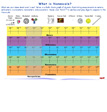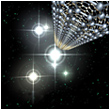Chemistry
Nanoscale Materials and Their Properties
| Unit 1 Poster Assessment Unit 2 Unit 3 |
|||
|
 |
||
| Unit 1: What is it? Students will: • Define nanoscience as the study of the fundamental principles of structures having at least one dimension lying roughly between 1 and 100 nanometers. |
 |
||
| Poster Assessment Students will: • Evaluate the implications of nanoscale research and technology. |
 |
||
| Unit 2: Metallic and Ionic Nanoparticles: Extendable Structures Students will: • Define extendable solids. |
 |
||
| Unit 3: Neat and Discrete Nanoparticles Students will: • Identify elements that can form discrete nanoparticles. |
 |
||
| CREDITS: | |
| Principal Investigators: John Ristvey, McREL Christine Morrow, SMART Bridges Developers: Dr. Donna Bogner, McREL John Ristvey, McREL Christine Morrow, SMART Bridges Earl Legleiter, McREL Jill Williams, McREL Deb Aruca, McREL Content Specialist/Remote Access: Dr. Mike Deal, Stanford University Reviewers: Dr. Mike Deal, Stanford University Professor Fred Goldberg, San Diego State University Dr. Marni Goldman, Stanford University Professor Daniel Schwartz, University of Colorado, Boulder Assessment: Dr. Beth Rajan-Sockman, Inspired Instruction Evaluators: Dr. Elisabeth Palmer, ASPEN Associates Suzanne Joyce, ASPEN Associates |
NanoLeap A Team Teachers and Co-Developers: Nicole Harmer, Brainerd HS, MN, Christina Lundgren, Brainerd HS, MN Dr. Roger Felch, Castleview HS, CO Dr. MaryAnn Varenka Martin, Estes Park HS, CO Tom Hessler, Sterling HS, CO Tug Sezen, Freedom HS, CA Field Test Teachers: Carla Burns, Kari Corbin, Steven Cornell, Bev Devore-Wedding, James Fabiano, Eric Goff, Nicole Grindle (King), Leighanna Hendderman, Maggie Helly, David Hill, Laura Hull, Delora Hutchinson, Kamala Kandi, Marilyn Kemp, Maria Masankay, Wynn Mott, Paul Ogle, Brian Roddiger, Todd Smeltz, Sherry Spurlock, Kari Steffin, Renee Teague, Julie Tipton, Patricia Voorstad, David Ziegler Layout: Graphics/Multimedia: |

